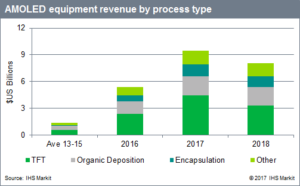The flat-panel display (FPD) industry is in the midst of a historic wave of building new factories to manufacture active matrix organic light emitting diode (AMOLED) displays according to IHS Markit. This will drive $9.5 billion worth of AMOLED-specific production equipment purchases in 2017.
The equipment used for producing TFT backplanes will account for 47% of the total market in 2017, worth $4.4 billion in revenues. Organic light-emitting layer deposition and encapsulation tools will generate record revenues of $2.2 billion and $1.2 billion, respectively, this year.
 “A variety of approaches can be used to deposit OLED materials. However, fine metal mask (FMM) evaporation tools, used for high-resolution mobile display production, account for the majority of the deposition equipment revenue in the current wave of new factory construction,” said Charles Annis, senior director at IHS Markit.
“A variety of approaches can be used to deposit OLED materials. However, fine metal mask (FMM) evaporation tools, used for high-resolution mobile display production, account for the majority of the deposition equipment revenue in the current wave of new factory construction,” said Charles Annis, senior director at IHS Markit.
Evaporation machines are technically highly complicated, consisting of multiple cluster vacuum tools linked by robots. Each tool consists of evaporation sources and mask-docking capabilities, and requires substantial pumping systems. The tools are typically very large and can exceed 100 metres in length at a high-volume production factory. This subsequently requires significant capital outlays.
“The market for high-performance AMOLED deposition equipment is dominated by Canon Tokki, which accounted for over half of the market in 2016,” Annis said. “At least five other evaporation makers are rushing to take advantage of the explosive market opportunity. However, with strong panel maker interest in Canon Tokki’s unrivaled mass production experience, we expect the company to make further market share gains in 2017.”
AMOLEDs also require high-performance encapsulation to prevent sensitive organic light-emitting materials from environmental degradation. Encapsulation barriers are typically fabricated from metal, glass or stacks of thin films. However, a substantial share of the new AMOLED factories now under construction will target production of plastic, flexible displays, which rely on cost intensive, multi-layer thin film encapsulation (TFE).
“Flexible AMOLED makers have done an incredible job simplifying their TFE structures over the past several years. Even so, the productivity of depositing high-quality inorganic films and printing organic layers all in a closed environment remains a complicated challenge,” Annis said. “The requirement of a large number of deposition chambers and auxiliary tools make TFE lines one of the largest segments of the AMOLED equipment market.”
With an estimated $23 billion of expenditures on AMOLED production equipment between 2016 and 2018, equipment makers, particularly those offering deposition and encapsulation solutions, will be enjoying a historic sales opportunity.

